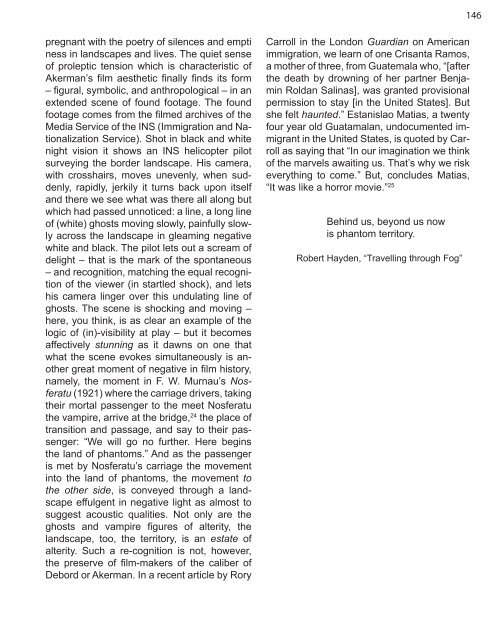Detroit Research Volume 1
Create successful ePaper yourself
Turn your PDF publications into a flip-book with our unique Google optimized e-Paper software.
146<br />
pregnant with the poetry of silences and empti<br />
ness in landscapes and lives. The quiet sense<br />
of proleptic tension which is characteristic of<br />
Akerman’s film aesthetic finally finds its form<br />
– figural, symbolic, and anthropological – in an<br />
extended scene of found footage. The found<br />
footage comes from the filmed archives of the<br />
Media Service of the INS (Immigration and Nationalization<br />
Service). Shot in black and white<br />
night vision it shows an INS helicopter pilot<br />
surveying the border landscape. His camera,<br />
with crosshairs, moves unevenly, when suddenly,<br />
rapidly, jerkily it turns back upon itself<br />
and there we see what was there all along but<br />
which had passed unnoticed: a line, a long line<br />
of (white) ghosts moving slowly, painfully slowly<br />
across the landscape in gleaming negative<br />
white and black. The pilot lets out a scream of<br />
delight – that is the mark of the spontaneous<br />
– and recognition, matching the equal recognition<br />
of the viewer (in startled shock), and lets<br />
his camera linger over this undulating line of<br />
ghosts. The scene is shocking and moving –<br />
here, you think, is as clear an example of the<br />
logic of (in)-visibility at play – but it becomes<br />
affectively stunning as it dawns on one that<br />
what the scene evokes simultaneously is another<br />
great moment of negative in film history,<br />
namely, the moment in F. W. Murnau’s Nosferatu<br />
(1921) where the carriage drivers, taking<br />
their mortal passenger to the meet Nosferatu<br />
the vampire, arrive at the bridge, 24 the place of<br />
transition and passage, and say to their passenger:<br />
“We will go no further. Here begins<br />
the land of phantoms.” And as the passenger<br />
is met by Nosferatu’s carriage the movement<br />
into the land of phantoms, the movement to<br />
the other side, is conveyed through a landscape<br />
effulgent in negative light as almost to<br />
suggest acoustic qualities. Not only are the<br />
ghosts and vampire figures of alterity, the<br />
landscape, too, the territory, is an estate of<br />
alterity. Such a re-cognition is not, however,<br />
the preserve of film-makers of the caliber of<br />
Debord or Akerman. In a recent article by Rory<br />
Carroll in the London Guardian on American<br />
immigration, we learn of one Crisanta Ramos,<br />
a mother of three, from Guatemala who, “[after<br />
the death by drowning of her partner Benjamin<br />
Roldan Salinas], was granted provisional<br />
permission to stay [in the United States]. But<br />
she felt haunted.” Estanislao Matias, a twenty<br />
four year old Guatamalan, undocumented immigrant<br />
in the United States, is quoted by Carroll<br />
as saying that “In our imagination we think<br />
of the marvels awaiting us. That’s why we risk<br />
everything to come.” But, concludes Matias,<br />
“It was like a horror movie.” 25<br />
Behind us, beyond us now<br />
is phantom territory.<br />
Robert Hayden, “Travelling through Fog”





